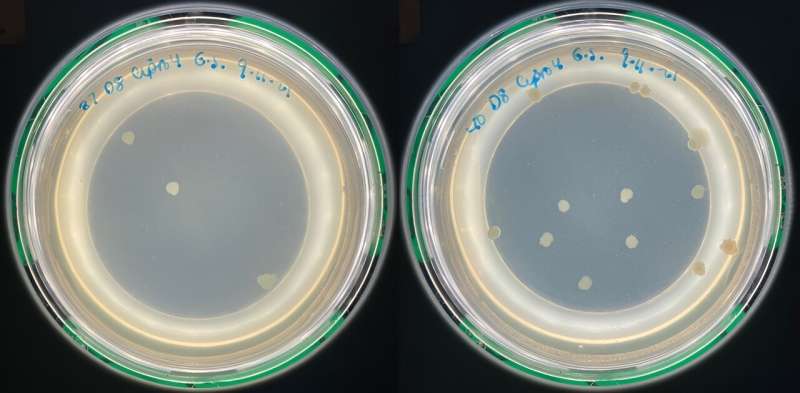
E. coli colonies growing on an agar plate containing ciprofloxacin: these resistant colonies originate from mutants. On the left resistant mutants originating from a population grown at 37 °C (normal body temperature), on the right resistant mutants originating from a population grown at 40 °C (temperature temperature). Credit: Eleanor Sheridan / University of Groningen
Scientists from the University of Groningen (Netherlands), together with colleagues from the University of Montpellier (France) and the University of Oldenburg (Germany), have tested how a fever can affect the development of antimicrobial resistance.
In laboratory experiments, they found that a small increase in temperature from 37 to 40 degrees Celsius drastically changed the mutation frequency in E. coli bacteria, which facilitates the development of resistance. If these results can be replicated in human patients, controlling fever could be a new way to mitigate the emergence of antibiotic resistance. The results were published in the journal JAC-Antimicrobial resistance.
Antimicrobial resistance of pathogens is a worldwide problem and recognized by the WHO as one of the major global threats to public health and development. There are two ways to combat this: by developing new drugs, or by preventing the development of resistance.
“We know that temperature affects the mutation rate in bacteria,” explains Timo van Eldijk, co-first author of the paper. “What we wanted to find out was how the increase in temperature associated with fever affects the rate of mutation towards antibiotic resistance.”
“Most studies on resistance mutations were done at reduced ambient temperature, and none, as far as we know, used a moderate increase above normal body temperature,” reports Van Eldijk. Together with Master’s student Eleanor Sheridan, Van Eldijk cultivated E. coli bacteria at 37 or 40 degrees Celsius and then exposed them to three different antibiotics to assess the effect.
He adds, “Again, some previous human trials have looked at fever and antibiotics, but in these studies the type of drug was not controlled.” In their laboratory study, the team used three different antibiotics with different modes of action: ciprofloxacin, rifampicin and ampicillin.
The results showed that for two of the drugs, ciprofloxacin and rifampicin, increased temperature led to an increase in the rate of mutation towards resistance. However, the third drug, ampicillin, caused a decrease in the rate of mutation towards resistance at feverish temperatures.
“To be sure of this result, we actually repeated the study with ampicillin in two different laboratories, at the University of Groningen and the University of Montpellier, and we got the same result,” says Van Eldijk.
The researchers hypothesized that a temperature dependence of the efficacy of ampicillin could explain this result and confirmed this in an experiment. This explains why resistance to ampicillin is less likely to arise at 40 degrees Celsius.
“Our study shows that a very mild change in temperature can drastically change the mutation rate towards antimicrobial resistance,” concludes Van Eldijk. “This is interesting, as other parameters such as growth rate do not seem to change.”
If the results are replicated in humans, this could pave the way to treating antimicrobial resistance by lowering the temperature with fever-suppressing drugs or giving patients with fever more effective antimicrobial drugs at higher temperatures. The team concludes in the paper, “An optimized combination of antibiotics and fever suppression strategies may be a new weapon in the battle against antibiotic resistance.”
More information:
Timo JB Van Eldijk et al, Temperature dependence of the antibiotic resistance mutation rate, JAC-Antimicrobial resistance (2024). DOI: 10.1093/jacamr/dlae085
Provided by the University of Groningen
citation: A new weapon in the battle against antibiotic resistance: Temperature (2024, June 14) retrieved June 15, 2024 from https://phys.org/news/2024-06-weapon-antibiotic-resistance-temperature.html
This document is subject to copyright. Except for any fair agreement for study or private research purposes, no part may be reproduced without written permission. The content is provided for informational purposes only.